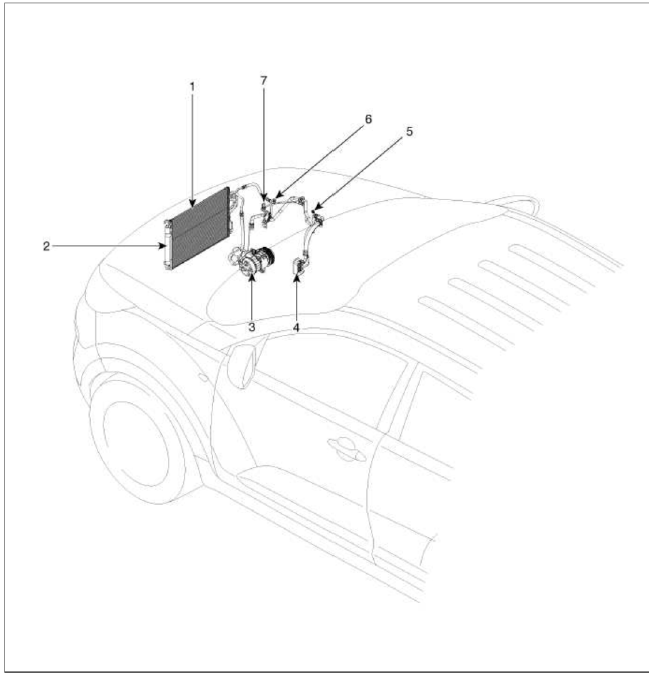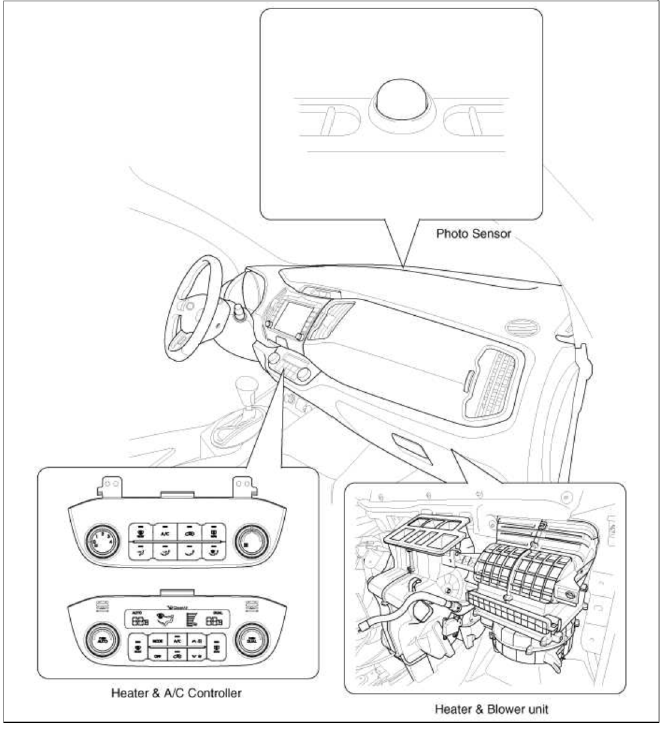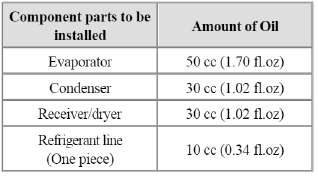Kia Sportage: Components and Components Location | Compressor Oil
Component Location Index
Engine Room

- Condenser
- Receiver-drier
- Compressor
- Expansion Valve
- Service port (High)
- Service port (Low)
- Ð/С Pressure
- Transducer
Interior

Compressor Oil
Repair procedures
Oil Specification
1. The HFC-134a system requires synthetic (PAG) compressor oil whereas the R-12 system requires mineral compressor oil. The two oils must never be mixed.
2. Compressor (PAG) oil varies according to compressor model. Be sure to use oil specified for the model of compressor.
Handling of Oil
1. The oil should be free from moisture, dust, metal powder, etc.
2. Do not mix with other oil.
3. The water content in the oil increases when exposed to the air. After rise, seal oil from air immediately. (HFC- 134a Compressor Oil absorbs moisture very easily.)
4. The compressor oil must be stored in steel containers, not in plastic containers.
Compressor Oil Check
The oil used to lubricate the compressor is circulating with the refrigerant.
Whenever replacing any component of the system or a large amount of gas leakage occurs, add oil to maintain the original amount of oil.
Oil total volume in system
PAG OIL : 120 +- 10 cc
Oil Return Operation
There is close affinity between the oil and the refrigerant.
During normal operation, part of the oil recirculation with the refrigerant in the system. When checking the amount of oil in the system, or replacing any component of the system, the compressor must be run in advance for oil return operation. The procedure is as follows:
1. Open all the doors and the engine hood.
2. Stall the engine and air conditioning switch to "ON" and set the blower motor control knob at its highest position.
3. Run the compressor for more than 20 minutes between 800 and 1,000 rpm in order to operate the system.
4. Stop the engine.
Replacement of Component Pails
When replacing the system component pails, supply the following amount of oil to the component pails to be installed.

For compressor Replacement, subtract the volume of oil drained from the removed compressor from the specified volume, and drain the calculated volume of oil from the new compressor:
The specified volume - volume of removed compressor = volume to drain from the new compressor.
NOTE
Even if no oil is drained from the removed compressor, don't drain more than 50cc from new compressor.
READ NEXT:
 Refrigerant line | Compressor
Refrigerant line | Compressor
Components and Components Location
Component Location
Repair procedures
Replacement
1. Discharge refrigerant from refrigeration system.
2. Replace faulty tube or hose.
CAUTION
Cap the o
SEE MORE:
 Heating and air conditioning automatically
Heating and air conditioning automatically
Press the AUTO button.
The modes, fan speeds, air intake and
air-conditioning will be controlled
automatically by setting the temperature.
Type A (button)
Type B (control panel)
You can control the air flow in three
stages by pushing the AUTO button
during automatic operation.
 Relay Box (Passenger Compartment)
Relay Box (Passenger Compartment)
Components and Components Location
Component Location
USE THE DESIGNATED FUSE AND
RELAY ONLY
Circuit (I/P Junction Box)
USE THE DESIGNATED FUSE AND
RELAY ONLY
Description and
Operation
Description
SJB (Smart Junction Box)
1. Specification
2. Rated Burden
3. Syste
Content
- Home
- Kia Sportage - Fifth generation (NQ5) - (2022-2025) - Owner's Manual
- Kia Sportage - Second generation (JEKM) (2005-2015) - Body Workshop Manual
- Kia Sportage Third generation (SL) - (2011-2016) - Service and Repair Manual
- Sitemap
- Top articles